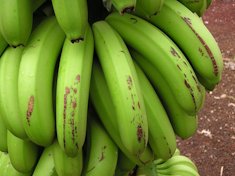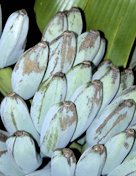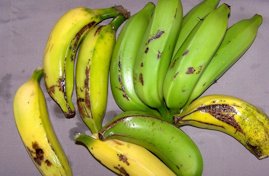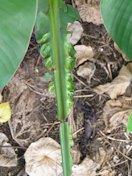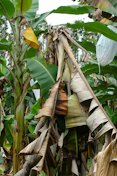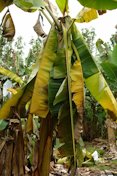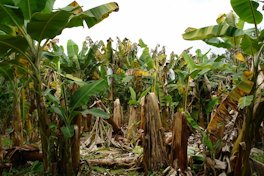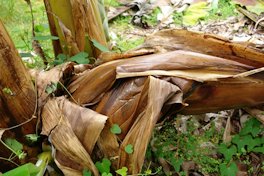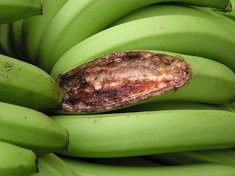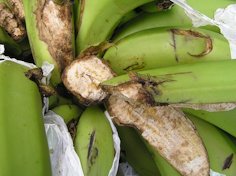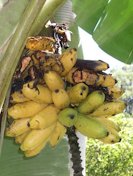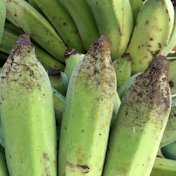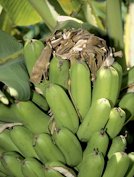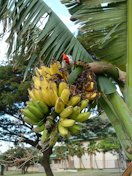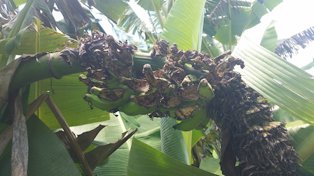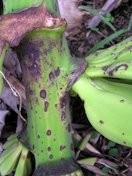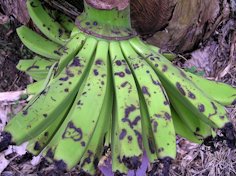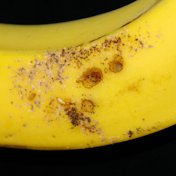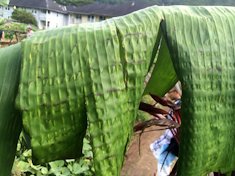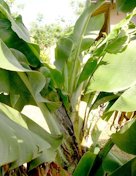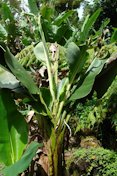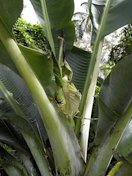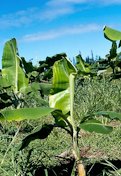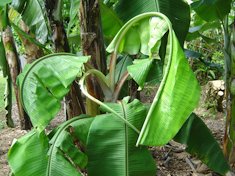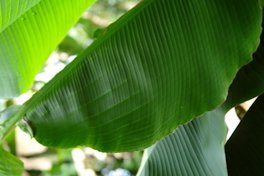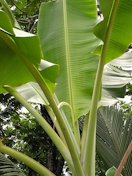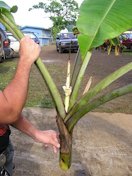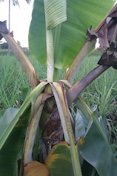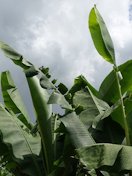Other Causes of Injury to Bananas Common Injuries
Fig. 1. Leaf rubbing scars Fig. 2. Banana fruit scarring, possibly due to leaf rubbing injury Fig. 3. Sap scars on banana fruits
Fig. 4,5. Glyphosate herbicide injury to banana foliage Lighting Injury
Fig. 6,7,8. Lightning injury to banana plants at a farm near Hilo, Hawai'i Fig. 9. Collapsed and broken banana pseudostem struck by lightning Animal Damage
Fig. 10,11,12. Rats feeding injury to banana fruit Fig. 13,14. Rat claws scratching injury to banana fruit peels Fig. 15. Rats feeding injury to plants and crops in Hawai'i, banana (rats nest)
Fig. 16. Bird-feeding injury to banana fruit Fig. 17. The red-crested cardinal (Paroaria coronata) feeding on banana fingers Fig. 18. Chicken feeding injury to banana fruits on the island of Kauai, Hawai'i Fig. 19,20. Ant damage to banana fruits via excretion of formic acid Fig. 21. Termites injury to banana fruit
Further Reading Control of Roof Rats in Fruit Trees, University of Florida pdf Rat Feeding Injury to Plants, University of Hawai'i at Mānoa pdf The Facts about Rats, US Fish & Wildlife Service, Pacific Islands Publications pdf Lightning Injury to Plants, University of Hawai'i at Mānoa pdf Older Material Rodents and Rodents Control in Hawaii, University of Hawai'i at Mānoa pdf Nutrient Deficiencies Boron
Boron deficiency symptoms: Fig. 22. Leaf rugosity Fig. 23,24. Boron deficiency of banana Fig. 25. Boron deficiency is expressed at the apical meristem Calcium
Calcium deficiency symptoms: Fig. 26. Yellow stripes perpendicular to leaf veins Fig. 28. Early foliar symptoms (yellow stripes parallel to leaf midrib) Fig. 29. Drooping and slightly chlorotic flag leaf (in severe cases the leaf is white in color with a necrotic tip) Fig. 30. Chlorotic (white) and/or necrotic heart leaf Fig. 31. Drooping, collapsed petioles and a whitish colored cigar leaf (the youngest leaf at the top of the plant) Fig. 32. Deformed, curled leaf blades at the apical meristem Back to Banana Page |
||||||||||||||||||||||||||||||||||||||||||||||||||||||||||||||||||
| Video Crane, Johathan H., and Ian Maguire. "Banana Series, Drough stress." University of Florida, IFAS/TREC. Photographs Fig. 1 Nelson, Scot C. "Leaf rubbing scars." Flickr, 2011, (CC BY-SA 2.0), www.flickr.com. Accessed 17 March 2017. Fig. 2 Nelson, Scot C. "Banana fruit scarring, possibly due to leaf rubbing injury." Flickr, 2006, (CC BY-SA 2.0), www.flickr.com. Accessed 17 March 2017. Fig. 3 Nelson, Scot C. "Sap scars on banana fruits." Flickr, 2007, (CC BY-SA 2.0), www. flickr.com. Accessed 17 March 2017. Fig. 4 Nelson, Scot C. "Glyphosate herbicide injury to banana foliage." Flickr, 2006, (CC BY-SA 2.0), www. flickr.com. Accessed 16 March 2017. Fig. 5 Nelson, Scot C. "Banana: Glyphosate herbicide injury." Flickr, 2013, (CC BY-SA 2.0), www. flickr.com. Accessed 16 March 2017. Fig. 6,7,8,9 Nelson, Scot C. "Lightning injury to banana plants at a farm near Hilo, Hawai'i." Flickr, 2006, (CC BY-SA 2.0), www.flickr.com. Accessed 17 March 2017. Fig. 10 Nelson, Scot C. "Rat injuries. " Flickr, 2011. University of Hawai'i at Mānoa, (CC BY-SA 2.0), www. flickr.com. Accessed 16 March 2017. Fig. 11 Nelson, Scot C. "Rat feeding injury to unripe banana fruits." Flickr, 2011, (CC BY-SA 2.0), www. flickr.com. Accessed 16 March 2017. Fig. 12 Kepler, Angela Kay. "Rats feeding injury to plants and crops in Hawai'i." Flickr, 2003, (CC BY-SA 2.0), www. flickr.com. Accessed 16 March 2017. Fig. 13,14 Nelson, Scot C. "Rat claws scratching injury to banana fruit peels."Flickr, 2014, (CC BY-SA 2.0), www. flickr.com. Accessed 17 March 2017. Fig. 15,16 Kepler, Angela Kay. "Rats feeding injury to plants and crops in Hawai'i. Banana (rats nest)." Flickr, 2007, (CC BY-SA 2.0), www. flickr.com. Accessed 17 March 2017. Fig. 17 Nelson, Scot C. "Bird-feeding injury to banana fruit." Flickr, 2015, (CC BY-SA 2.0), www. flickr.com. Accessed 16 March 2017. Fig. 18 Nelson, Scot C. "The red-crested cardinal (Paroaria coronata) feeding on banana fingers." Flickr, 2015, (CC BY-SA 2.0), www. flickr.com. Accessed 17 March 2017. Fig. 19 Nelson, Scot C. "Chicken feeding injury to banana fruits on the island of Kauai, Hawai'i." Flickr, 2014, (CC BY-SA 2.0), www. flickr.com. Accessed 17 March 2017. Fig. 20,21 Nelson, Scot C. "Ant damage to banana fruits via excretion of formic acid." Flickr, 2006, (CC BY-SA 2.0), www. flickr.com. Accessed 16 March 2017. Fig. 22 Nelson, Scot C. "Termites injury to banana fruit. Kea'au, Hawai'i." Flickr, 2009, (CC BY-SA 2.0), www. flickr.com. Accessed 16 March 2017. Fig. 22 Cousin, Marisa. "Banana Boron deficiency (mild). Symptom: Leaf rugosity." Flickr, 2014, (CC BY-SA 2.0), www. flickr.com. Accessed 16 March 2017. Fig. 23,24,25 Nelson, Scot C. "Boron deficiency of banana." Flickr, 2004, 2005, 2006, (CC BY-SA 2.0), www. flickr.com. Accessed 16 March 2017. Fig. 26 Nelson, Scot C. "Calcium deficiency of banana. Yellow stripes perpendicular to leaf veins." Flickr, 2017, (CC BY-SA 2.0), www. flickr.com. Accessed 17 March 2017. Fig. 27 Nelson, Scot C. "Banana: Calcium deficiency." Flickr, 2007, (CC BY-SA 2.0), www. flickr.com. Accessed 17 March 2017. Fig. 28 Nelson, Scot C. "Calcium deficiency of banana. Early foliar symptoms (yellow stripes parallel to leaf midrib)." Flickr, (CC BY-SA 2.0), www.flickr.com. Accessed 17 March 2017. Fig. 29 Nelson, Scot C. "Calcium deficiency of banana. Symptom: Drooping and slightly chlorotic flag leaf (in severe cases the leaf is white in color with a necrotic tip)." Flickr, 2003, (CC BY-SA 2.0), www. flickr.com. Accessed 17 March 2017. Fig. 30 Nelson, Scot C. "Calcium deficiency of banana. Chlorotic (white) and/or necrotic heart leaf. " Flickr, 2003, (CC BY-SA 2.0), www. flickr.com. Accessed 17 March 2017. Fig. 31 Nelson, Scot C. "Calcium deficiency of banana. Symptoms: Drooping, collapsed petioles and a whitish colored cigar leaf (the youngest leaf at the top of the plant)." Flickr, 2013, (CC BY-SA 2.0), www. flickr.com. Accessed 17 March 2017. Fig. 32 Nelson, Scot C. "Banana: Calcium (Ca) deficiency. Symptom: Deformed, curled leaf blades at the apical meristem." Flickr, 2016, (CC BY-SA 2.0), www.flickr.com. Accessed 17 March 2017. Published 21 Mar. 2014 LR. Last update 10 Oct. 2020 LR |
||||||||||||||||||||||||||||||||||||||||||||||||||||||||||||||||||
